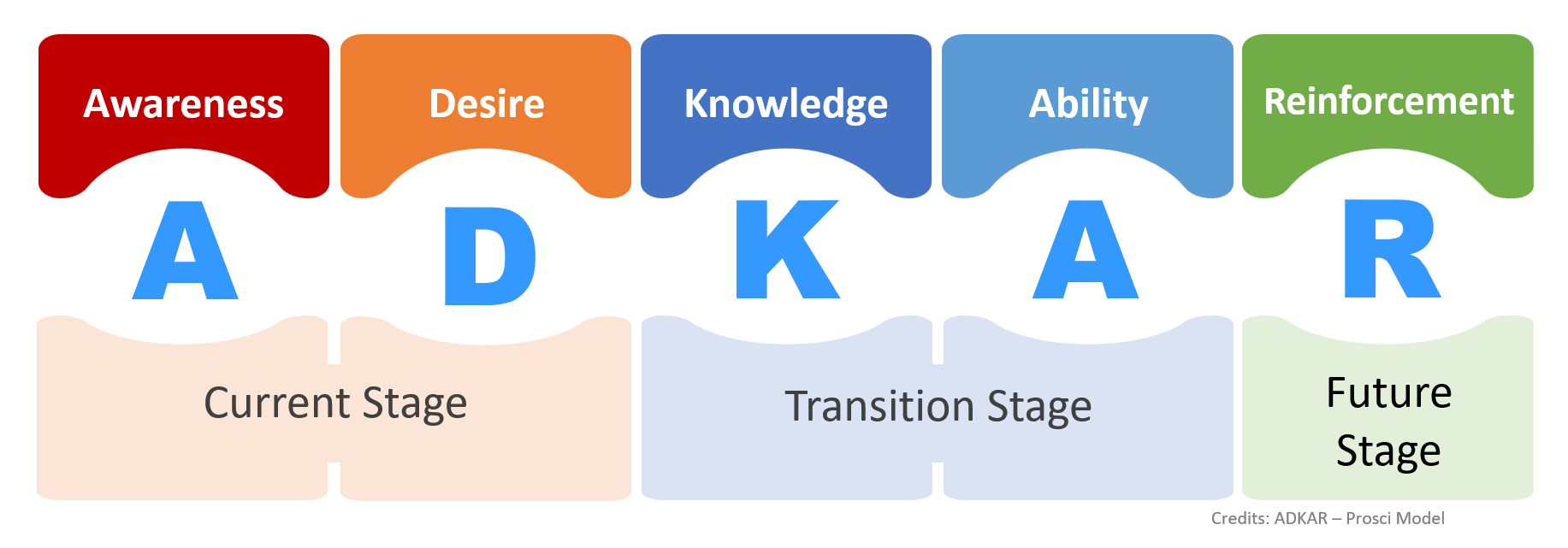Published by: Tamer Elogueil
What is the Prosci ADKAR® Model?
The Prosci ADKAR® Model is a goal-oriented change management tool designed to guide individuals and organisations through the process of change. The model was founded by Jeff Hiatt in 2003 and introduced as a practical tool by Prosci, a leading organisation in change management research and methodologies. The acronym ADKAR stands for the five tangible and concrete outcomes that people and organisations need to achieve the required change: Awareness, Desire, Knowledge, Ability, and Reinforcement.
Introduction to Change Management
Change management is critical for organisations to adapt and thrive in today's fast-paced business environment. Effective change management ensures that changes are implemented smoothly, with minimal resistance and maximum engagement from employees. Structured models like ADKAR provide a clear roadmap for navigating the complexities of organisational change.
Historical Context
Jeff Hiatt, a prominent figure in change management, developed the ADKAR model after extensive research and observation of organisational change processes. Prosci, the organisation behind ADKAR, has contributed significantly to the field with comprehensive research and practical tools that have been adopted by over 900 organisations across 59 countries.
Why the ADKAR Model?
The ADKAR model serves as an effective and widely utilised tool for planning change management activities, facilitating leadership alignment, and guiding employees through change transitions. By focusing on the human aspect of change, the ADKAR model fosters organisational success by ensuring each individual embraces and contributes to the change journey. Its structured approach allows organisations to navigate the complexities of change, fostering resilience and agility.
Applying the ADKAR model to change initiatives enables:
- Employees to comprehend the benefits of adopting new technologies and methodologies.
- Preparation of employees for the evolving organisational landscape.
- Equipping leaders with tools to manage change and overcome resistance effectively.
- Viewing change as an ongoing process rather than a one-time event.
Detailed Phases of ADKAR
The ADKAR model delineates the three stages of change into distinct phases:
- Current Stage: Awareness & Desire
- Transition Stage: Knowledge & Ability
- Future Stage: Reinforcement

Awareness
During the awareness phase, leadership plays a pivotal role in ensuring employees understand the rationale and necessity for impending changes. Effective communication strategies, including internal corporate communication tools, face-to-face meetings, and one-to-one sessions, are essential for fostering awareness and mitigating uncertainty. Leaders need to ensure their people understand “What Changes are going to Occur?” and the “Why are these changes needed?”.
Keeping people unaware can be detriment and lead to loss of direction and motivation. Leader have a crucial role at this phase on ensuring the employees are fully aware of all the activities and elements included in the transition process.
It is recommended to adapt a planned open approach in communication. This can be achieved through some means such as:
- Utilising internal corporate communication tools such as emails and media platforms.
- Facilitated face-to-face team meetings or corporate events.
- One-to-one meetings if needed and deemed necessary for some levels.
Desire
In this phase, cultivating employee willingness to support and engage in the change process is paramount. Addressing individual incentives and aligning the change with personal values fosters a sense of ownership and commitment among employees, driving sustained change adoption.
Knowledge
Change necessitates the acquisition of new skills and knowledge among employees. Providing comprehensive training programmes, supplemented by coaching and on-the-job learning opportunities, empowers employees to develop the competencies required for successful change implementation.
Ability
Transitioning from theoretical knowledge to practical application is central to the ability phase. Supporting employees through practice, continuous feedback, and coaching interventions bridges the gap between learning and performance, ensuring individuals achieve desired outcomes.
Reinforcement
Sustaining change requires ongoing reinforcement mechanisms to prevent regression to previous behaviours. Positive feedback, rewards, and continuous recognition of performance cultivate a culture of resilience and adaptability, reinforcing the organisation's commitment to change excellence.
Benefits of the ADKAR Model
The ADKAR model offers multifaceted benefits, including:
- Enhanced strategic focus and organisational alignment.
- Improved employee engagement and morale.
- Greater agility and adaptability in navigating change.
- Sustainable change outcomes and long-term organisational success.
Challenges and Solutions
Implementing the ADKAR model may encounter challenges such as resistance to change and communication barriers. Overcoming these challenges necessitates proactive measures, including cross-functional collaboration, effective governance structures, and targeted communication strategies.
Comparison with Other Models
While the ADKAR model focuses on individual change, complementary models such as Kotter’s 8 Step Approach and Lewin’s Change Management Model address broader organisational dynamics. Understanding the synergies and distinctions between these models empowers organisations to leverage diverse approaches for change excellence.
Tools and Resources
Prosci offers a myriad of tools and resources to support ADKAR implementation, ranging from templates to training programmes. Additionally, supplementary resources such as books, articles, and online courses enrich practitioners' knowledge and skills in change management.
Future Trends in Change Management
As organisations embrace digital transformation and embrace remote work, the role of change management continues to evolve. Emerging trends such as AI-driven analytics and a renewed focus on employee experience underscore the importance of adaptable change management methodologies like ADKAR.
Conclusion
The Prosci ADKAR® Model embodies a holistic approach to change management, empowering organisations to navigate change with confidence and resilience. Its structured framework, rooted in human-centric principles, ensures sustainable change outcomes and fosters a culture of continuous improvement. By embracing the ADKAR model, organisations position themselves for success in an ever-evolving business landscape.
Tips: Explore additional change management frameworks such as "Kotter’s 8 Step Approach" and "Galpin's Change Resistance Pyramid" for comprehensive change management strategies.

Comments
No Comments added, be the first...